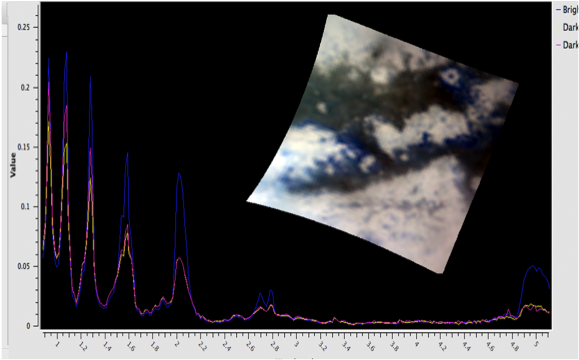VIMS data sets are archived by the PDS (Imaging Node) at the Jet Propulsion Laboratory and USGS - Flagstaff.
Raw Data Products
VIMS QUBEs -
Online Access PDS-D Search
Higher Order Products
VIMS Rings Occultation Data -- Preliminary Version
Access via ISIS - The ISIS 3 software package can be used to process data from the Imaging Science Subsystem (ISS), Visual and Infrared Mapping Spectrometer (VIMS) and RADAR. You will find
step-by-step instructions for cartographic and science data to create your own products.
A
Guide to the Planetary Atlas that introduces search options and a tutorial on review and retrieval of Cassini data can be found at the Imaging Node.
Enhanced Search
Searches constrained by improved target definition and geometric parameters for the surfaces of Saturn and the satellites, as well as for rings observations, are available.
more
Higher Order Products -
Ring Occultation Profiles- reduced & calibrated optical depth profiles for Saturn's rings derived from VIMS stellar occultation observations.
Continuing Refinement of Documentation and Calibration
IR Pixel Timing
VIMS is being used in modes that were not a part of the initial instrument design. Because the VIMS infrared channel uses an articulating secondary mirror to produce a raster scan of the scene being observed, users who wish to construct geometry for individual pixels within the scan must deal with characteristics of the VIMS internal clock. A white paper,
VIMS IR Pixel Timing, has been generated and the resulting refinement has been included in the ISIS software package.
IR Wavelength Calibration 8/10/15
VIMS' IR wavelength calibration has been observed to be drifting toward longer wavelengths over the roughly 10 years since the start of the Cassini orbital tour. The shift amounts to about 9 nm, or about 0.6 channels over the roughly 10.5 years since the start of the Cassini orbital tour. The reasons for the shift are unknown at present. The shift was detected and quantified by observing changes in the peaks of the atmospheric transmission windows in Titan's reflectance spectrum in the near infrared. Since the wavelength shift was recognized, the VIMS team has initiated wavelength calibration checks using the internal calibration diode built into the IR channel. As of November 2014, the drift toward longer wavelengths in the VIMS IR channel continues.
Going forward from approximately June, 2014, the wavelength calibration of VIMS will be determined solely using its internal calibration diode. The present plan has the VIMS team performing diode calibrations every few days throughout the rest of the Cassini mission, starting approximately June 2014. See the
current spreadsheet of results.
A New Radiometric Calibration 9/21/15
We derive a
new radiometric calibration for the Visual and Infrared Mapping Spectrometer (VIMS) on Cassini. Since entering orbit in 2004, the VIMS instrument has undergone small shifts in the wavelength calibration of the spectrometer. The maximum shift is currently 10.4 nm (0.65 channels) and is estimated to be 0.71 channels at the end of mission. The wavelength shifts now require a time-dependent radiometric calibration technique to be deployed to preserve radiometric accuracy. Herein we quantify the time-dependent wavelength shift, and describe a compensatory scheme that will provide an accurate calibration for both specific intensity and I/F for VIMS measurements made during the Cassini Mission.
Other Useful Products and Other Resources for Interpreting the Data
See the
Master Schedule for a time ordered listing of observations by all instruments.
Imaging Node Aids
SPICE - Archived Cassini SPICE ancillary data providing observation geometry (positions, orientations, instrument pointing, time conversions and the like) are available from the PDS
NAIF Node.
Publications - A listing of team members to facilitate literature searches.
 PDS: The Planetary Atmospheres Node
PDS: The Planetary Atmospheres Node
